Famous Vanitas Paintings – Discover the Best Vanitas Artworks
What is Vanitas painting? The futility of life can seem like a bleak subject to delve into but these famous vanitas paintings and their symbolic imagery make the idea of death and human existence in its prime seem appealing. Vanitas painting is a genre of painting that not many people are aware of, especially in our Contemporary era of digital art and art forms that are more centered around the future of our existence. Vanitas paintings can be just as informative about human life and demonstrate the simple ideals that most people still strive for today. In this article, we will unpack a detailed Vanitas meaning as well as some of the most famous Vanitas paintings in art history and how these paintings demonstrate the essence of Vanitas.
An Introduction to Vanitas Painting
Vanitas, meaning “vanity” in Latin, refers to a genre of painting concerned with a particular period in art history that demonstrated the vanity of human existence by drawing attention to particular objects charged with symbolic meaning.
This genre of painting became known as Vanitas painting and was extremely popular during the 17th century.
The idea of using objects as symbols of human delight and earthly existence may sound like a deep philosophical subject that if translated visually, might translate as a complex arrangement of symbols. The art of capturing vanity is not easy but for the artists of the 17th century, still-life painting was one way to illustrate the essence of the subject.
The Essence of Vanitas Painting in Art: A Vanitas Meaning
To unpack a detailed Vanitas meaning, one needs to examine the source of the concept itself. The essence of Vanitas painting comes from the biblical passage of Ecclesiastes, quoted as “vanity of vanities, saith the Preacher, vanity of vanities, all is vanity” and is a reminder of the futility of the pursuit of material possessions since death is something that no one can escape. Vanitas paintings thus serve as a reminder of our mortality. This may also remind you of the phrase memento mori, which is a reminder of the shortness of human life and translates to “remember you must die”.
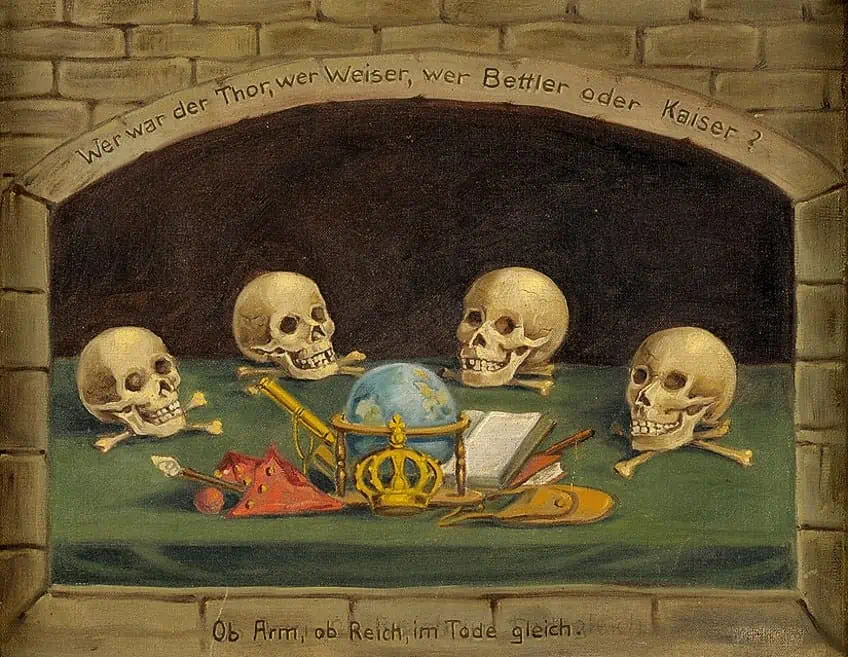
Common Symbols in Vanitas Painting
Many Vanitas paintings that you will find below all share a few common symbols illustrated by different objects in a painting. Some of the most common symbols found in a Vanitas painting include many inanimate objects such as plates, food, jewelry, and cups.
One of the main features of a vanitas still life painting is a skull, symbolic of the ultimate event in human life, death.
Artists would often include different motifs and symbols depending on their geographical region and the preferences of the time. Common motifs include symbols of wealth as portrayed by jewelry, gold, coins, or purses, maps, and books to indicate knowledge, symbols of pleasure such as food, wine, and textiles, and finally candles, flowers, hourglasses, and skulls to represent decay and a sense of finality to human existence.

Vanitas painting withdrew from the realms of commercial popularity toward the end of the Dutch Golden Age but the genre of still-life painting remained a largely influential aspect of art that would influence many artists to follow. The impact of Vanitas paintings was lost among the other subjects considered more important and eventually declined in production.
The final days of Vanitas painting took a more positive turn and were replaced by outlooks informed by beauty, aesthetic pleasure, and increased experimentation in art styles.
The Value of Vanitas Painting
What value do Vanitas paintings hold for us today? It is worth considering the reinvention of a Vanitas painting in line with the “pleasures” of today. Artists working from a multidisciplinary perspective may benefit from the philosophical influence of the Vanitas genre and the idea of memento mori as other forms of embodiment, aside from the common Vanitas symbols featured in Dutch art. Many Vanitas symbols of the past are still found in Contemporary settings.
These include the skull, which remains a symbol of the inevitability of our death and the ever-increasing desire to alter the course of nature’s will.
Top 10 Most Famous Vanitas Paintings
Vanitas paintings are not all doom and gloom. This fascinating genre of painting can broaden your perspective of what it means to remember one’s mortality while appreciating the pursuit of the finer things in life. Below, you will find the most famous Vanitas paintings in art history that capture the essence of Vanitas and shed light on the different forms of vanity as highlighted by incredible artists.
The Ambassadors (1533) by Hans Holbein the Younger
| Artist Name | Hans Holbein the Younger (1497 – 1543) |
| Date | 1533 |
| Medium | Oil on oak |
| Dimensions (cm) | 207 x 209.5 |
| Where It Is Housed | The National Gallery, London, England |
This vivid painting by German-Swiss artist Hans Holbein the Younger is one of the earliest acquired Vanitas artworks by the National Gallery and remained in England since the 19th century. The painting was created by the famous Hans Holbein who signed the work in 1533 and was one of the few works signed by Holbein. Scholars concluded that Holbein probably saw this work as an important piece and therefore included his name on the painting.
The Ambassadors depict two men on either side of the painting with a shelf stationed between them and various Vanitas objects scattered on the shelf.
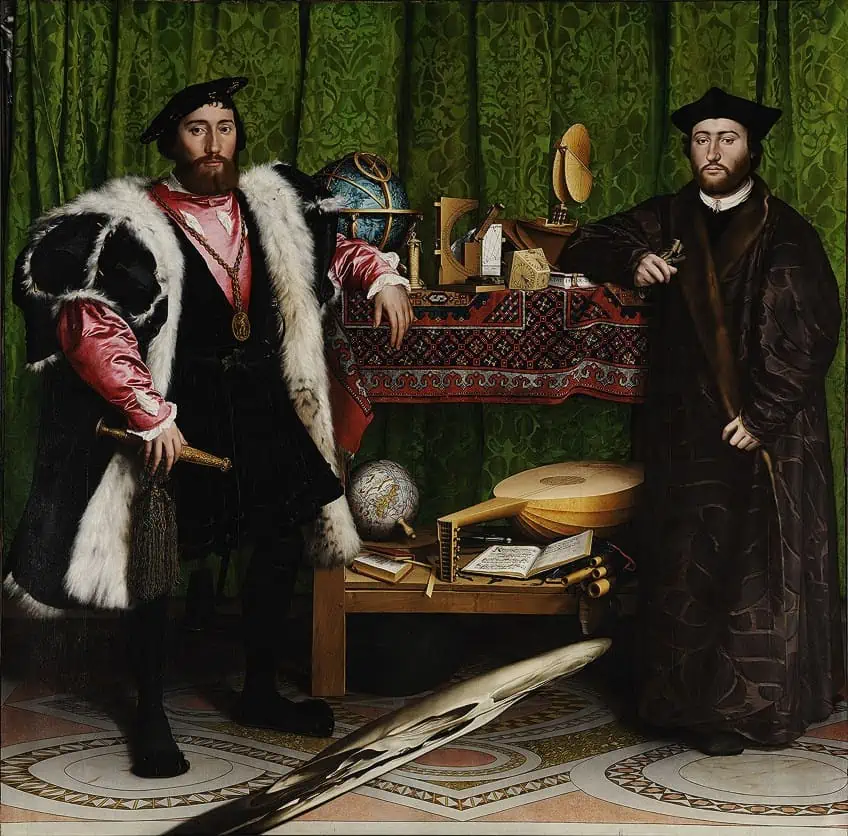
The men are believed to be the French ambassador as seen on the left and the Bishop of Lavaur as seen on the far right. The placement of the men alongside the various Vanitas objects relays the message that these men are educated, traveled, and have the privilege of experiencing the pleasures of life as they stand proudly next to their life’s greatest accomplishments.
The bottom of the painting strikes one’s eye with a distorted image of a skull and is an odd reminder of mortality and certain death.
The upper left corner of the painting is occupied by a crucifix and is the only positive element in the painting, which was considered uncommon for most Vanitas paintings. The insertion of the cross allows the viewer to experience hope amidst the numerous objects that remind one of certain death. The crucifix is a symbol of hope and salvation, of eternal life after the pleasures of earthly life only if one passes judgment.
St Jerome Doing Penance in his Study (1618 – 1622) by Luis Tristán
| Artist Name | Luis Tristán de Escamilla (1586 – 1624) |
| Date | 1618 – 1622 |
| Medium | Oil on canvas |
| Dimensions (cm) | 174 x 108 |
| Where It Is Housed | Museo del Greco, Toledo, Spain |
This famous Vanitas artwork was created between 1618 and 1622 by Luis Tristán and portrays the image of St Jerome, a prominent intellectual figure who was active in the 4th century and was also known for being somewhat of a recluse character. His hermit-like character is expertly illustrated among the objects of vanity, including a cross, skull, and other items.
His position is one of penance together with the cross, skull, and apocalyptic trumpet in the top right corner, and Cardinal’s hat in the bottom right corner.
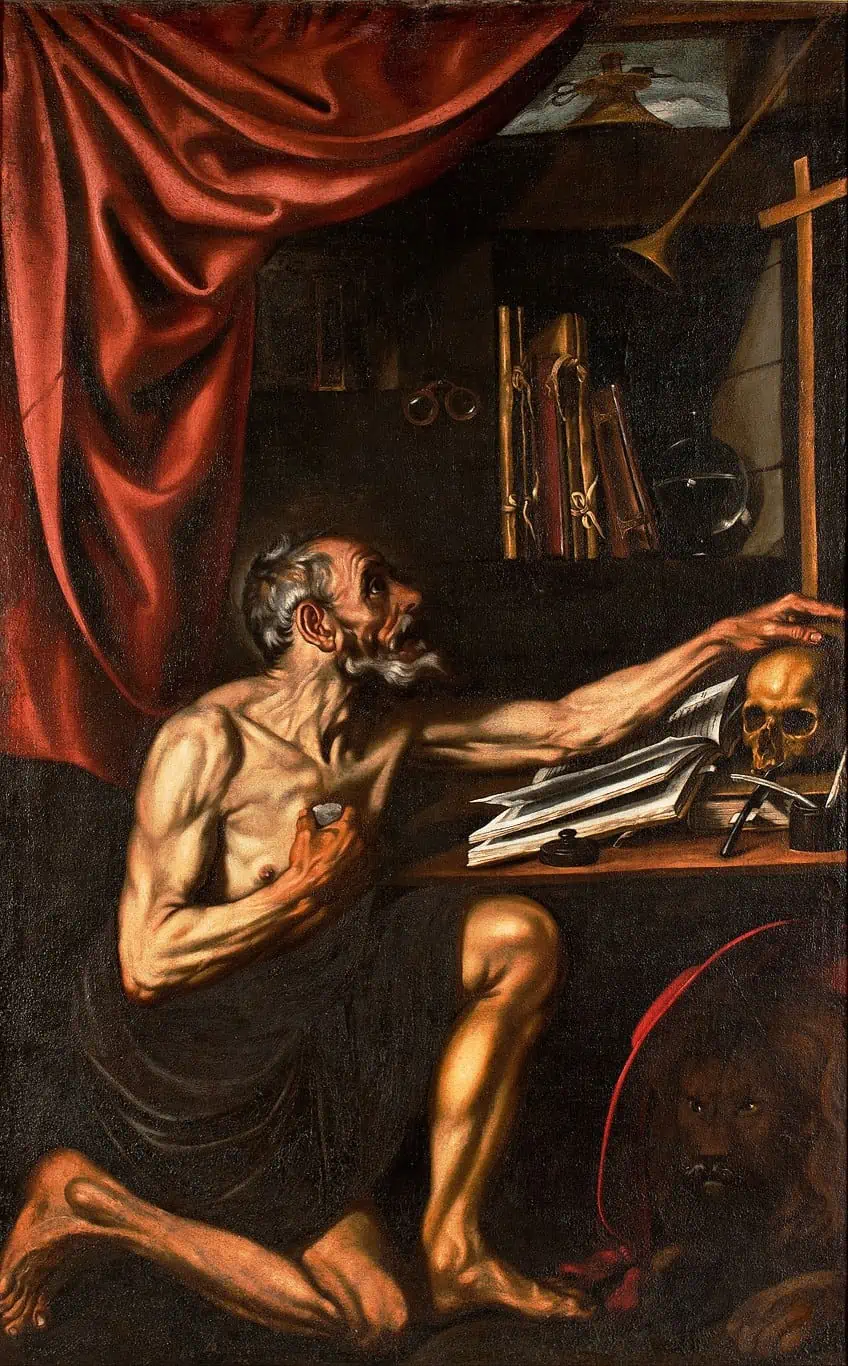
Luis Tristán was a Spanish Mannerist painter who operated in Toledo for the majority of his career. Many of his works are based on religious themes and demonstrate his transition toward a Counter-Reformation style with a few Caravaggisti influences.
St Jerome Doing Penance in his Study was not originally made to be a Vanitas artwork but its image of St Jerome in his study relays the perspective of many Vanitas artists, that is, transcendence.
St Jerome is seen looking toward the cross or symbolically, looking toward God while his hand touches the skull. This gesture is a symbol of the saint’s dedication to God in light of the fleeting pleasures of the world. His gesture of penance stands out among the Vanitas objects and a sense of both suffering and hope is evoked.
Vanitas Still Life (1625) by Pieter Claesz
| Artist Name | Pieter Claesz (1597 – 1661) |
| Date | 1625 |
| Medium | Oil on panel |
| Dimensions (cm) | 29,5 x 34,4 |
| Where It Is Housed | Frans Hals Museum, Haarlem, Netherlands |
Vanitas Still Life by famous Vanitas artist Pieter Claesz is an iconic painting that illustrates the vanity of life in such a classical manner that it has become “the face of Vanitas painting” since its creation. The painting was created in 1625 by Claesz, a Dutch Golden Age painter specializing in still-life painting. As you might know by now, still-life painting is an important aspect of Vanitas painting and is essentially the foundation of Vanitas artwork.
In Vanitas Still Life, Pieter Claesz presents a still-life of a candlestick, a pen, a letter, a watch, an inkpot, a skull, a walnut, and a flower on a table.
All the objects in the painting are classical symbols associated with Vanitas art and are a clear nod to the passage of time and mortality. Presented in a Baroque style, Claesz paints a freshly picked anemone flower alongside the skull, which alludes to the fact that the vitality of the flower is only temporary and that it will not be long until it withers and dies.

Ovid, a Roman poet once referred to the anemone as a windflower because its lifespan is so short. The message of time slipping away and the flower, therefore, refers to the futility of life. Claesz is most famous for his monochrome still life paintings and in Vanitas Still Life, Pieter Claesz skillfully demonstrates his abilities.
Each Vanitas object is rendered with such detail and brilliance in the light of a candle.
Some of the most beautiful aspects of the painting are the way that Claesz rendered objects such as the skull and candle wax with close attention to the effect of light and shadow as well as how the candlelight affects the texture of each object. Claesz was 21 when he was established as a “fully-qualified painter” and raised his son as a painter to take after his practice. Claesz specialized in banquet paintings and breakfast pieces.
Allegory of Vanity (1632 – 1636) by Antonio de Pereda
| Artist Name | Antonio de Pereda y Salgado (1611 – 1678) |
| Date | 1632 – 1636 |
| Medium | Oil on canvas |
| Dimensions (cm) | 1740 x 1395 |
| Where It Is Housed | Kunsthistorisches Museum, Vienna, Wien, Austria |
This magnificent Vanitas painting was created by Spanish Baroque still-life painter, Antonio de Pereda who offered a slightly different approach to the genre of Vanitas painting. Pereda includes a woman among the arrangement of Vanitas objects who appears to pose for the painting as though she is unaware of the grim subject of vanity and certain death.
The morbidity of the scene is enhanced by the beauty of the woman, which further elaborates on the idea of beauty and vanity in temporary youth.

The painting’s title suggests that it is an allegory of vanity and that the woman is thus not living in the present moment, rather, she is more aware of her “eternal destiny in the afterlife”. Not much is known about the rest of Pereda’s career aside from his education in Madrid and clear influences from Netherlandish art. Pereda also includes motifs related to wartime fame, science, and happiness in marriage among other traditional symbols.
The winged woman holds a portrait of Emperor Charles V while her right-hand points to a globe.
Still Life with Oysters, a Silver Tazza, and Glassware (1635) by Willem Claesz
| Artist Name | Willem Claesz. Heda (c. 1593/1594 – 1680/1682) |
| Date | 1635 |
| Medium | Oil on wood |
| Dimensions (cm) | 49.8 x 80.6 |
| Where It Is Housed | The Metropolitan Museum of Art, New York, United States |
This gorgeous Vanitas painting was created by Dutch still-life painter Willem Claesz. Heda in 1635. The painting is rendered in such high detail that it is incomparable to any other Vanitas painting of the 17th century. Heda was a talented painter who invented the late breakfast genre in still-life painting. Heda was the son of Claes Pietersz, who was an architect for Haarlem.
Still Life with Oysters, a Silver Tazza, and Glassware is an example of one of Heda’s best paintings from his mature period in the 1630s and showcases his fine workmanship in additive brushstrokes, coloration, and a remarkable sense of Realism.
The left of the painting contains oyster shells that lie in front of a plate of fresh oysters, waiting to be consumed. The glimmer of the silver spoon guides the viewer’s eye to a shard of glass while a knife with an ebony and ivory handle is positioned on the edge of the table. The most realistic object among the stunning illustration of silverware is the cut lemon and a paper cone on a pewter plate. The paper cone is said to be a page from an almanac and is a reminder of the fact that life on earth is always numbered. A broken wine glass that has fallen over is another reference to the temporary nature of “worldly pleasures”.

A leather-covered knife on the right edge of the table mirrors the knife on the left and directs the viewer’s eye to Heda’s signature. The pewter plates work harmoniously with the silver tazza that lies on its side to reveal an untarnished base. The entire arrangement may at first seem inviting yet upon close inspection, the tiny details reveal much more. Heda utilized various pictorial effects seen on the reflective glass, the glistening oysters, and the polished silverware that are worked in a monochromatic fashion.
This monochrome Vanitas banquet is a fascinating exploration of color, light, texture, and value that Heda brings to life through the varying hues of brown, yellow, silver, green, and white.
Still life: An Allegory of the Vanities of Human Life (c. 1640) by Harmen Steenwjick
| Artist Name | Harmen van Steenwjick (1612 – 1656) |
| Date | c. 1640 |
| Medium | Oil on oak |
| Dimensions (cm) | 39.2 x 50.7 |
| Where It Is Housed | The National Gallery, London, England |
This Vanitas painting is one of the most direct references to the confrontation of death, captured by the focal object in the frame, the skull. This is one of the most famous Baroque Vanitas paintings and is admired for evoking the dramatic nature of the skull accompanied by the shaft of light that pierces the empty eye sockets and the ticking watch, which hastens the impending sense of mortality in the viewer. The painting was completed around 1640 by Harmen Steenwjick who was a famous Dutch still-life painter.
The main message follows the message of most Vanitas paintings and draws attention to the futility of human endeavors represented by musical instruments, an expensive Japanese sword, and books.
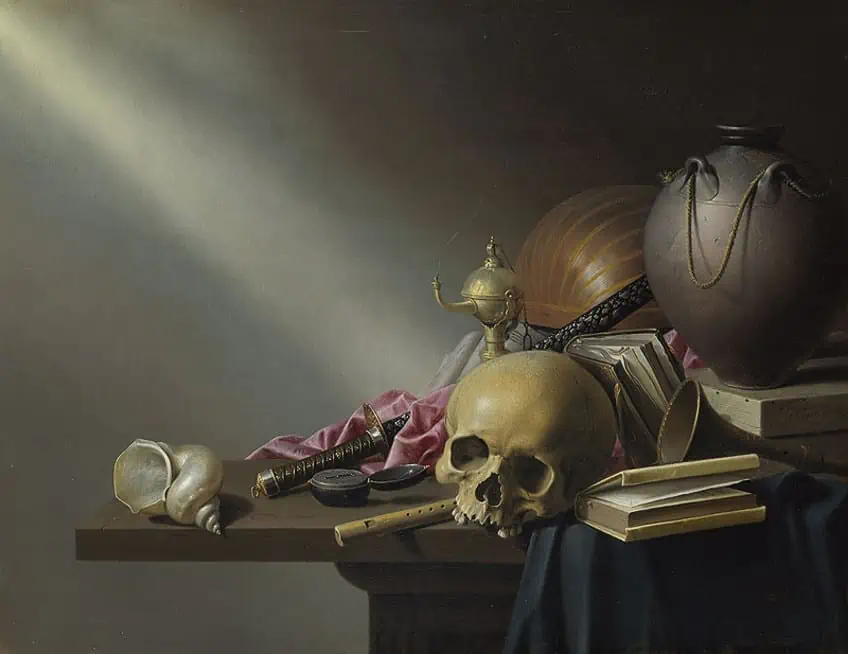
Another interesting object in the painting is the Turbinidae shell, which is commonly found in South East Asia and serves as a symbol of wealth. At the time, only wealthy collectors would have owned such specimens as rare mementos from foreign lands. Shells in art also symbolize fertility and birth.
The soft purple silk fabric represents physical luxury since silk was considered a fine material and purple was one of the most expensive dye colors.
The Samurai sword also serves a double purpose; it symbolizes superior craftsmanship and militant power. Samurai swords are known for their extremely sharp quality, handmade by skilled swordsmiths. The presence of a Samurai sword alludes to the honor and display of leadership, bravery, courage, and military force of man, to conquer. It is thus a symbol of ambition.
Vanitas Still Life (1648) by Jan Jansz
| Artist Name | Jan Jansz. Treck (1606 – 1652) |
| Date | 1648 |
| Medium | Oil on oak |
| Dimensions (cm) | 90.5 x 78.4 |
| Where It Is Housed | The National Gallery, London, England |
This reminiscent image is often thought of as one of the most somber Vanitas paintings in art history. Vanitas Still Life was created in 1648 by Jan Jansz. Treck, a painter under the Dutch Golden Age and an admirer of the work of Pieter Claesz. Treck’s Vanitas paintings were often filled with many objects strewn about in a way that evokes a sense of “that which is long gone”.
His still-lifes portray expensive objects that convey complex meanings around common Vanitas themes, including the shortness of life, greed, destructive habits, and luxuries, which in the end, are of no value.
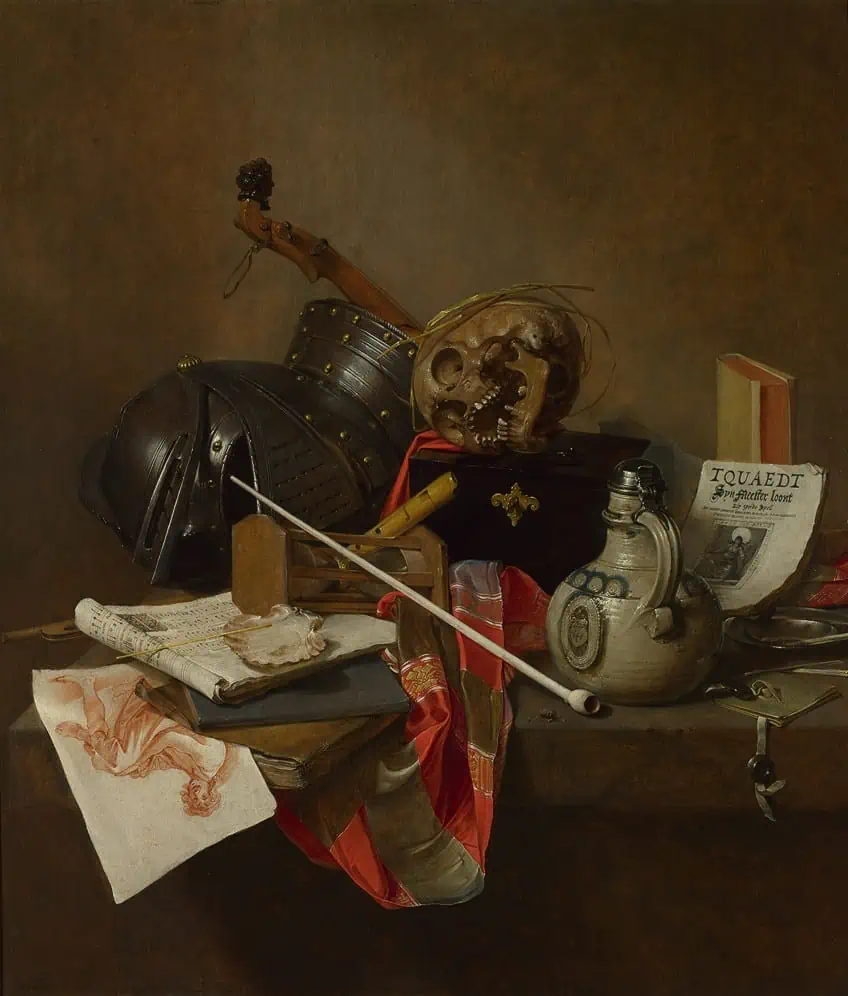
What amplifies the depressing nature of this painting is the placement of straws on the skull, which is overturned on its side with its jaw slightly open. The lack of importance placed on the skull only highlights the lack of importance of the objects around the skull.
The skull is also the closest representation of a human that was once alive, now strewn about the table as part of a still life, which leads back to the vanity and futility of the entire scene.
Still Life with a Volume of Wither’s ‘Emblemes’ (1696) by Evert Collier
| Artist Name | Evert Collier (Edward Collier) (1642 – 1707) |
| Date | 1696 |
| Medium | Oil on canvas |
| Dimensions (cm) | Support: 83.8 x 107.9 and frame: 100.4 x 124.2 x 7 |
| Where It Is Housed | Tate Museum, London, England |
This complex Vanitas painting leaves no room for wondering what the subject of the still-life is. The painting visually states that it is a Vanitas painting as seen in the top left corner with a paper and text printed on it announcing “Vanitas”. Still Life with a Volume of Wither’s ‘Emblemes’ is a painting that is embedded with the pleasures of life during the late 17th century. It contains jewelry, wine, musical instruments, a skull, an hourglass, and silverware, which mark the fleeting moments of pleasure in life.
The book on the left side of the painting is open and, on its pages, one can see a poem that emphasizes the subject of mortality.
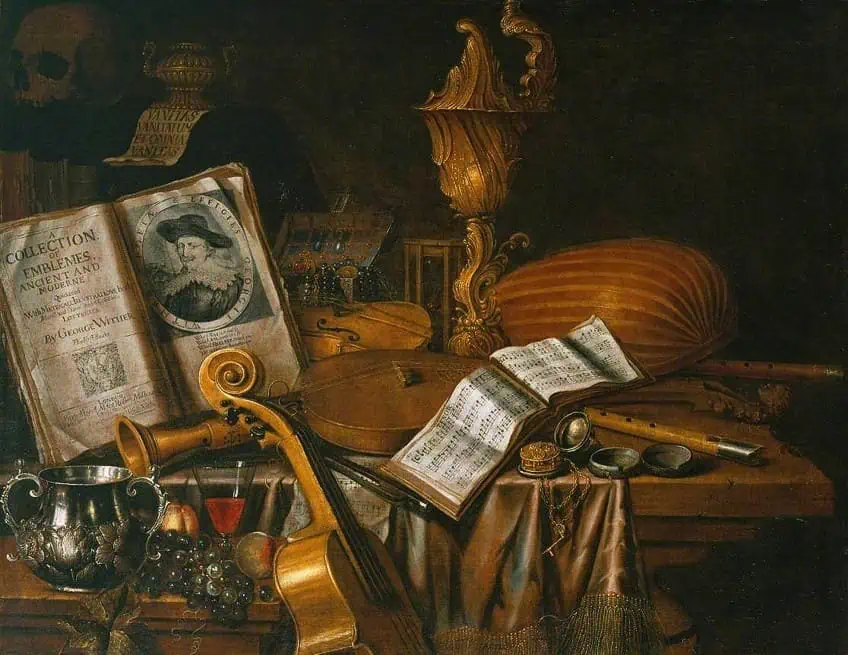
The painting was created in 1696 by Dutch painter Edward Collier who moved to England in 1693 to pursue his art in still-life painting and produce work for the English art market. Not much information remains about the artist, however, many of his works feature English texts and symbols that catered to the English environment.
This was a common strategy used by Dutch artists to ease into the market and cater to the audience.
Still Life with Skull (1896 – 1898) by Paul Cézanne
| Artist Name | Paul Cézanne (1839 – 1906) |
| Date | 1896 – 1898 |
| Medium | Oil on canvas |
| Dimensions (cm) | 54 x 65 |
| Where It Is Housed | Barnes Foundation, Philadelphia, United States |
Created by famous post-Impressionist Paul Cézanne, this famous Vanitas painting is one of the most colorful and “upbeat” Vanitas paintings in comparison to the Vanitas Baroque style approach of the early 17th century. Still Life with Skull was created during the latter stages of Cézanne’s career and was also an indication of the artist’s tendency toward exploring more serious themes such as mortality. This differs from his earlier subjects that portray leisurely activities and is represented as a softer outlook on death.
Cézanne was so highly revered by his contemporaries that Picasso even claimed Cézanne to be the father of them all.
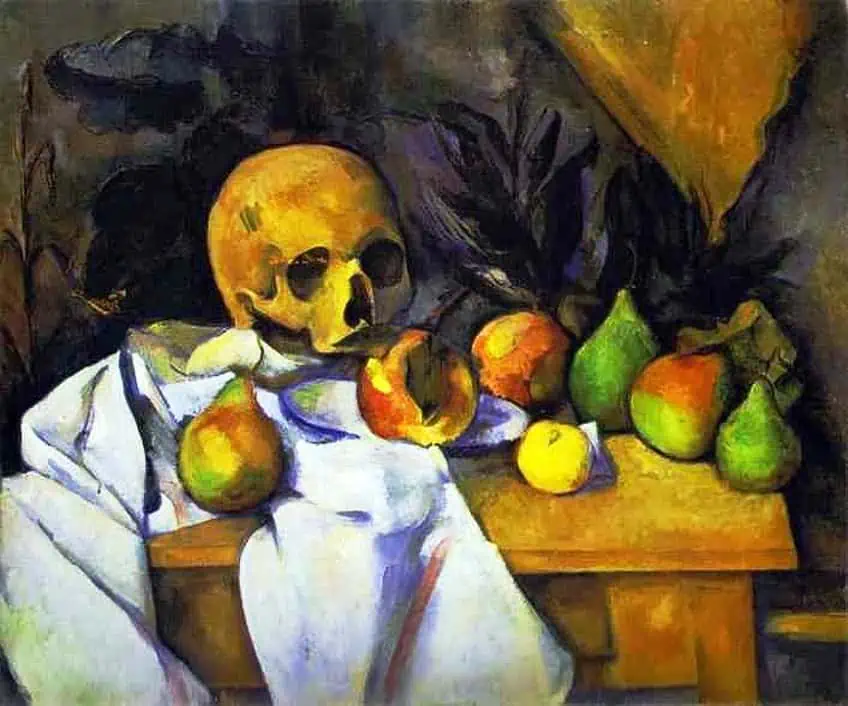
Between 1898 and 1905, Cézanne was preoccupied with the imagery of skulls and continued to place skulls at the forefront of his paintings. Cézanne is also celebrated for contributing to the mending of the division between Impressionism and Cubism, thus establishing himself as a seeker of modernity.
While focusing on the theme of Vanitas toward the later stages in his career, Cézanne faced backlash from the bourgeoisie of Aix-en-Provence and even received a few death threats for his work, then-considered “ugly”.
Another famous Vanitas painting by Cézanne is Three Skulls on an Oriental Carpet (1904), which according to a witness, changed its color and form every day. Cézanne was known to dedicate himself to the study of his subjects and one can only speculate the reasons why he was so “restless” in painting Vanitas artwork.
Black Jug and Skull (1946) by Pablo Picasso
| Artist Name | Pablo Ruiz Picasso (1881 – 1973) |
| Date | 1946 |
| Medium | Lithograph on paper |
| Dimensions (cm) | Support: 33 x 44 Frame: 55.6 x 67.6 x 5.5 |
| Where It Is Housed | Tate, London, England |
This black and white Vanitas artwork was created by Pablo Picasso in 1946 and includes an image of a jug and a human skull with an open book on a table. Picasso used lithographic crayon and ink to create this quirky Picasso-styled version of a then-lost tradition of Vanitas painting. Picasso’s Vanitas print breaks the traditional depictions of Vanitas painting with an aesthetic approach.
Picasso maintains a somber attitude in the print by casting shadows on the corners of the image and highlighting certain high-contrast areas such as the skull and the jug.
The Vanitas print is believed to hold meaning related to the suffering and loss of human life during World War II. The very same day that this print was produced, Picasso also made Composition with Skull (1946), which demonstrates an identical composition to that of Black Jug and Skull.
Picasso was known to be superstitious toward death and even kept a skull in his studio.
Vanitas Painting in Retrospect
While reflecting on the genre of Vanitas painting in art history, one can begin to unpack the role of this genre for the artist and what that role means beyond the veil of death, morbidity, and the futility of earthly pleasures. Vanitas paintings also draw attention to a deeper level of self-reflection on the part of the artist. This self-reflection within a still-life scenario is a corporeal representation of individuals who were defined by their social identities.
These social identities were informed by symbols of wealth, power, and Vanitas symbols, which can be seen in many Vanitas paintings.
At the dawn of Vanitas painting in the Netherlands, many artists relied on their professionals and social status to help advance their careers and recognition in the arts. Vanitas painting was recognized as a genre of morals that question the validity of such pleasures and “frivolous” pursuits and which throw the viewer into the pit of introspection. The move away from Vanitas painting demonstrates less emphasis on morals and instead was hyper-fixated on “getting art right” as opposed to jumping into the deep end of moral philosophy.

Examples of Contemporary Vanitas artwork can also be found in still-life photography with artists such as Laura Letinsky, Margriet Smulders, and Richard Kuiper who reimagine the genre through the modern medium of photography. Many of the re-imagined works still carry similar symbols and continue to reference pioneering Vanitas artists such as Adriaen Coorte and Pieter Claesz.
The Vanitas movement ended around 1650 but continued to serve as an important theme in the work of many famous artists. Despite the Vanitas movement losing its popularity, similar themes of the vanity of life and memento mori can be found in Contemporary works by artists such as Damien Hirst, Alexander James, Hannah Matthews, Soozy Lipsey, Paulette Tavormina, Jeroen Luijt, and many more.
Frequently Asked Questions
What Is Vanitas in Art?
Vanitas in art refers to the painting genre that was popular between the 16th and late 17th centuries. Vanitas directly translates to vanity and is derived from a passage in the Bible referring to the vanity of man and the futility demonstrated in the pursuit of earthly pleasures since death is inevitable. This was the core message of Vanitas paintings in art.
What Are Vanitas Symbols?
Vanitas symbols are certain objects used in Vanitas still-life paintings to represent the various pleasures of life, usually accompanied by a skull as a symbol of mortality. Common Vanitas symbols include musical instruments, books, maps, objects of time, food, jewelry, expensive goods, textiles, and other objects that relay opulence, greed, desire, and temporary happiness.
Who Was the Most Famous Vanitas Painter?
The most famous Vanitas painter is considered to be Pieter Claesz (1597 – 1661), who was a famous Dutch Golden Age painter of still-lifes. Pieter Claesz is admired for his mastery in the handling of light, texture, and composition in Vanitas painting.
What Was the First Vanitas Still Life?
Most believed that the first Vanitas still-life painting is Vanitas Still-Life (1603) by Jacques de Gheyn who was a talented and wealthy draftsman. The painting is regarded as the earliest independent example of Vanitas in a painting that portrays the subject of human vanity. However, examples of Vanitas subjects can be seen in earlier works such as The Ambassadors (1533) by Hans Holbein the Younger.
Jordan Anthony is a Cape Town-based film photographer, curator, and arts writer. She holds a Bachelor of Art in Fine Arts from the University of the Witwatersrand, Johannesburg, where she explored themes like healing, identity, dreams, and intuitive creation in her Contemporary art practice. Jordan has collaborated with various local art institutions, including the KZNSA Gallery in Durban, the Turbine Art Fair, and the Wits Art Museum. Her photography focuses on abstract color manipulations, portraiture, candid shots, and urban landscapes. She’s intrigued by philosophy, memory, and esotericism, drawing inspiration from Surrealism, Fluxus, and ancient civilizations, as well as childhood influences and found objects. Jordan is working for artfilemagazine since 2022 and writes blog posts about art history and photography.
Learn more about Jordan Anthony and about us.
Cite this Article
Jordan, Anthony, “Famous Vanitas Paintings – Discover the Best Vanitas Artworks.” artfilemagazine – Your Online Art Source. January 11, 2023. URL: https://artfilemagazine.com/famous-vanitas-paintings/
Anthony, J. (2023, 11 January). Famous Vanitas Paintings – Discover the Best Vanitas Artworks. artfilemagazine – Your Online Art Source. https://artfilemagazine.com/famous-vanitas-paintings/
Anthony, Jordan. “Famous Vanitas Paintings – Discover the Best Vanitas Artworks.” artfilemagazine – Your Online Art Source, January 11, 2023. https://artfilemagazine.com/famous-vanitas-paintings/.



